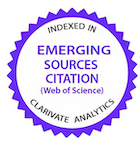Determinação da diversidade microbiana na conjuntiva ocular de cães saudáveis pelo sequenciamento completo do DNA
DOI:
https://doi.org/10.1590/1809-6891v25e-77549EResumo
A conjuntiva desempenha papel fundamental na saúde e imunidade ocular e atua como uma barreira à entrada de microrganismos. As infecções conjuntivais são comuns em cães e resultam tanto da invasão de microrganismos patogênicos quanto do crescimento descontrolado da microbiota existente. A maior parte dos dados existentes provém de estudos baseados em métodos de cultura tradicionais. Esses relatos apontam para o predomínio de bactérias gram-positivas, principalmente Staphylococcus spp. O presente estudo analisou a comunidade microbiana presente na conjuntiva ocular de uma população heterogênea de cães sem distúrbios oftalmológicos por sequenciamento de DNA. Após exame oftálmico minucioso, foram coletados suabe conjuntivais de ambos os olhos de 30 cães. Após processamento e extração de ácidos nucleicos, o pool de amostras foi submetido ao sequenciamento shotgun de DNA por meio da plataforma Illumina e analisado no servidor Metagenomic Rapid Annotations using Subsystems Technology (MG-RAST). Foi identificada uma predominância do filo Proteobacteria e dos gêneros Ralstonia e Burkholderia juntamente com uma minoria de fungos, enquanto vírus não foram encontrados. O sequenciamento do DNA microbiano trouxe novos dados sobre o assunto, revelando a presença de organismos não cultiváveis até então desconhecidos como parte do microbioma ocular.
Downloads
Referências
Andrade AL, Stringhini G, Bonello FL, Marinho M, Perri SHV. Conjunctival microbiota of healthy dogs in Araçatuba city (SP) [Conjunctival microbiota of healthy dogs in Araçatuba city (SP)]. Arq Bras Oftalmol [Internet]. 2002 Jun [cited 2019 May 5];65:323–326. Available from: https://doi.org/10.1590/S0004-27492002000300008 Portuguese.
Galera PD, Ávila MO, Ribeiro CR, Santos FV.. Estudo da microbiota da conjuntiva ocular de macacos-prego (Cebus apella–LINNAEUS, 1758) e macacos bugio (Alouatta caraya–HUMBOLDT, 1812), provenientes do reservatório de Manso, MT, Brasil. Arq Inst Biol [Internet]. 2002 Apr [cited 2020 May 12];69:33-36. Available from: http://www.biologico.agricultura.sp.gov.br/uploads/docs/arq/V69_2/galera.pdf Portuguese.
Maggs DJ. Eyelids. In: Slatter’s Fundamentals of Veterinary Ophthalmology. 4. ed. St Louis: Saunders Elsevier; 2008. p. 107–134.
Armstrong RA. The microbiology of the eye. Ophthalmic Physiol Opt. 2000;6:429–441. https://doi.org/10.1111/j.1475-1313.2000.tb01121.x
Murphy JM, Lavach JD, Severin GA. Survey of conjunctival flora in dogs with clinical signs of external eye disease. J Am Vet Med Assoc. 1978;172:66-68. https://europepmc.org/article/med/624664
Ledbetter EC, Mun JJ, Kowbel D, Fleiszig SMJ.. Pathogenic phenotype and genotype of Pseudomonas aeruginosa isolates from spontaneous canine ocular infections. Invest Ophthalmol Vis Sci. 2009;50:729-736. https://doi.org/10.1167/iovs.08-2358
Oria AP, Pinna MH, Furtado MA, Pinheiro ACO, Gomes Junior DC, Costa Neto JM.. Microbiota conjuntival em cães clinicamente sadios e cães com ceratoconjuntivite seca. Ciênc Anim Bras. 2013;14:495-500. https://doi.org/10.5216/cab.v14I4.19210
Buyukmihci N. Ocular lesions of blastomycosis in the dog. J Am Vet Med Assoc [Internet]. 1982 Feb [cited 2021 Mar 19];180:426-431. Available from: https://escholarship.org/uc/item/8t04b5vh
Scott EM, Carter RT. Canine keratomycosis in 11 dogs: a case series (2000–2011). J Am Anim Hosp Assoc. 2014;50:112-118. https://doi.org/10.5326/JAAHA-MS-6012
Decaro N, Campolo M, Elia G, Buonavoglia D, Colaianni ML, Lorusso A, et al.Infectious canine hepatitis: an “old” disease reemerging in Italy. Res Vet Sci. 2007;83:269-273. https://doi.org/10.1016/j.rvsc.2006.11.009
Almeida DE, Roveratti C, Brito FL, Godoy GS, Duque JCM, Bechara GH, et al. Conjunctival effects of canine distemper virus‐induced keratoconjunctivitis sicca. Vet Ophthalmol. 2009;12:211-215 https://doi.org/10.1111/j.1463-5224.2009.00699.x
Ledbetter EC, Hornbuckle WE, Dubovi EJ. Virologic survey of dogs with naturally acquired idiopathic conjunctivitis. J Am Vet Med Assoc. 2009;235:954-959. https://doi.org/10.2460/javma.235.8.954
Ledbetter EC, Kim SG, Dubovi EJ, Bicalho RC. Experimental reactivation of latent canine herpesvirus-1 and induction of recurrent ocular disease in adult dogs. Vet Microbiol. 2009;138:98-105. https://doi.org/10.1016/j.vetmic.2009.03.013
McDonald PJ, Watson ADJ. Microbial flora of normal canine conjunctivae. J Small Anim Pract. 1976;17:809-812. https://doi.org/10.1111/j.1748-5827.1976.tb06947.x
Wang L, Pan Q, Zhang L, Xue Q, Cui J, Changming Q. Investigation of bacterial microorganisms in the conjunctival sac of clinically normal dogs and dogs with ulcerative keratitis in Beijing, China. Vet Ophthalmol. 2008;11:145-149. https://doi.org/10.1111/j.1463-5224.2008.00579.x
Santos LGF, Almeida ABPF, Silva MC, Oliveira JT, Dutra V, Souza VRF. Microbiota conjuntival de cães hígidos e com afecções oftálmicas [Conjunctival microorganisms from healthy dogs and with eye diseases]. Acta Sci Vet [Internet]. 2009 [cited 2022 May 18];37(2):165-169. Available from: https://www.redalyc.org/pdf/2890/289021830008.pdf
Verneuil M, Durand B, Marcon C, Guillot J. Conjunctival and cutaneous fungal flora in clinically normal dogs in southern France. J Mycol Med. 2014;24:25-28. https://doi.org/10.1016/j.mycmed.2013.11.002
Leis ML, Costa MO. Initial description of the core ocular surface microbiome in dogs: bacterial community diversity and composition in a defined canine population. Vet Ophthalmol. 2019;22:337-344. https://doi.org/10.1111/vop.12599
Lima DA, Cibulski SP, Finkler F, Teixeira TF, Varela APM, Cerva C, et al. Faecal virome of healthy chickens reveals a large diversity of the eukaryote viral community, including novel circular ssDNA viruses. J Gen Virol. 2017;98:690-703. https://doi.org/10.1099/jgv.0.000711
Dong Q, Brulc JM, Iovieno A, Bates B, Garoutte A, Miller D, et al. Diversity of bacteria at healthy human conjunctiva. Invest Ophthal Vis Sci. 2011;52:5408-5413. https://doi.org/10.1167/iovs.10-6939
Huang Y, Yang B, Li W. Defining the normal core microbiome of conjunctival microbial communities. Clin Microbiol Infect. 2016;22:643-647. https://doi.org/10.1016/j.cmi.2016.04.008
Ozkan J, Nielsen S, Diez-Vives C, Coroneo M, Thomas T, Willcox M. Temporal stability and composition of the ocular surface microbiome. Sci Rep. 2017;7:1-11. https://doi.org/10.1038/s41598-017-10494-9
Vaz-Moreira I, Egas C, Nunes OC, Manaia CM. Culture-dependent and culture-independent diversity surveys target different bacteria: a case study in a freshwater sample. Antonie Van Leeuwenhoek. 2011;100:245-257. https://doi.org/10.1007/s10482-011-9583-0
Carter GR, Cole JR. Classification, normal flora and laboratory safety. In: Diagnostic procedures in veterinary bacteriology and mycology. 2. ed. San Diego: Academic Press; 1990. p. 1–8. https://doi.org/10.1016/B978-0-12-161775-2.50005-0
Kluge M, Campos FS, Tavares M, Amorim DB, Valdez FP, Giongo A, et al. Metagenomic survey of viral diversity obtained from faeces of Subantarctic and South American fur seals. PLoS One [Internet]. 2016 Mar [cited 2020 Aug 12];11:e0151921. Available from: https://doi.org/10.1371/journal.pone.0151921
Weber MN, Cibulski SP, Olegario JC et al. Characterization of dog serum virome from Northeastern Brazil. Virology. 2018;525:192-199. Available from: https://doi.org/10.1016/j.virol.2018.09.023
Alves CDBT, Budaszewski RF, Cibulski SP, Silva MS, Puhl DE, Mósena ACS, et al. Mamastrovirus 5 detected in a crab-eating fox (Cerdocyon thous): Expanding wildlife host range of astroviruses. Comp Immunol Microbiol Inf Dis. 2018;58:36-43. https://doi.org/10.1016/j.cimid.2018.08.002
Liu Z, Yang S, Wang Y, Shen Q, Yang Y, Deng X, et al. Identification of a novel human papillomavirus by metagenomic analysis of vaginal swab samples from pregnant women. Virol J. 2016;13:1-7. https://doi.org/10.1186/s12985-016-0583-6
Quinn PJ, Markey BK, Leonard FC et al. Nature, structure and taxonomy of viruses. In: Veterinary Microbiology and Microbial Disease. 2. ed. West Sussex: Wiley-Blackwell;2011. p. 505–508.
Suchodolski JS, Morris EK, Allenspach K, Jergens AE, Harmoinen JA, Westermarck E, et al. Prevalence and identification of fungal DNA in the small intestine of healthy dogs and dogs with chronic enteropathies. Vet Microbiol. 2008;132:379-388. https://doi.org/10.1016/j.vetmic.2008.05.017
Foster ML, Dowd SE, Stephenson C, Steiner JM, Suchodolski JS. Characterization of the fungal microbiome (mycobiome) in faecal samples from dogs. Vet Med Int [Internet]. 2013 Apr [cited 2023 July 09]:e658373:1-8. Available from: https://doi.org/10.1155/2013/658373
Prado MR, Rocha MF, Brito ÉH, Girão MD, Monteiro AJ, Teixeira MFS, et al. Survey of bacterial microorganisms in the conjunctival sac of clinically normal dogs and dogs with ulcerative keratitis in Fortaleza, Ceará, Brazil. Vet Ophthalmol. 2005;8:33-37. https://doi.org/10.1111/j.1463-5224.2005.04061.x
Allaker RP, Lloyd DH, Simpson AI. Occurrence of Staphylococcus intermedius on the hair and skin of normal dogs. Res Vet Sci. 1992;52:174-176. https://doi.org/10.1016/0034-5288(92)90006-N
Fazakerley J, Nuttall T, Sales D, Schmidt V, Carter SD, Hart CA, et al. Staphylococcal colonization of mucosal and lesional skin sites in atopic and healthy dogs. Vet Dermatol. 2009;20:179-184. https://doi.org/10.1111/j.1365-3164.2009.00745.x
Watanabe K, Nakaminami H, Azuma C, Tanaka I, Nakase K, Matsunaga N, et al. Methicillin-resistant Staphylococcus epidermidis is part of the skin flora on the hands of both healthy individuals and hospital workers. Biol Pharm Bull [Internet]. 2016 Aug [cited 2021 Apr 21]:b16-00528. Available from: https://doi.org/10.1248/bpb.b16-00528
Barrow GI. Microbial antagonism by Staphylococcus aureus. Microbiol. 1963;31:471-481. https://doi.org/10.1099/00221287-31-3-471
Weese SJ, Nichols J, Jalali M, Litster, A. The oral and conjunctival microbiotas in cats with and without feline immunodeficiency virus infection. Vet Res. 2015;46:1-11. https://doi.org/10.1186/s13567-014-0140-5
Ryan MP, Adley CC. Ralstonia spp.: emerging global opportunistic pathogens. Eur J Clin Microbiol & Infect Dis. 2014;33:291-304. https://doi.org/10.1007/s10096-013-1975-9
Hoffmann AR, Patterson AP, Diesel A, Lawhon SD, Ly HJ, Stephenson CE, et al. The skin microbiome in healthy and allergic dogs. PloS one [Internet]. 2014 Jan [cited 2022 Jan 08]:9:e83197. Available from: https://doi.org/10.1371/journal.pone.0083197
LaFrentz S, Abarca E, Mohammed HH, Cuming R, Arias CR. Characterization of the normal equine conjunctival bacterial community using culture‐independent methods. Vet Ophthalmol. 2020;23:480-488. https://doi.org/10.1111/vop.12743
Chen KJ, Sun MH, Hou CH, Sun CC, Chen TL. Burkholderia pseudomallei endophthalmitis. J Clin Microbiol. 2007;45:4073-4074. https://doi.org/10.1128/JCM.01467-07
Parkes HM, Shilton CM, Jerrett IV, Benedict S, Spratt BG, Godoy D, et al. Primary ocular melioidosis due to a single genotype of Burkholderia pseudomallei in two cats from Arnhem Land in the Northern Territory of Australia. J Feline Med Surg. 2009;11:856-863. https://doi.org/10.1016/j.jfms.2009.02.009
Lloyd JM, Suijdendorp P, Soutar WR. Melioidosis in a Dog. Aust Vet J. 1988;65:191-192. https://doi.org/10.1111/j.1751-0813.1988.tb14300.x
Makkar NS, Casida-Junior LE. Cupriavidus necator gen. nov., sp. nov.; a nonobligate bacterial predator of bacteria in soil. Int J Syst Evol Microbiol. 1987;37:323-326. https://doi.org/10.1099/00207713-37-4-323
Ray J, Waters RJ, Skerker JM, Kuehl JV, Price MN, Huang J, et al. Complete genome sequence of Cupriavidus basilensis 4G11, isolated from the Oak Ridge field research center site. mBio [Internet]. 2015 May [cited 2021 Oct 23]:3:e00322-15. Available from: https://doi.org/10.1128/genomeA.00322-15
Langevin S, Vincelette J, Bekal S, Gaudreau C. First case of invasive human infection caused by Cupriavidus metallidurans. J Clin Microbiol. 2011;49:744-745. https://doi.org/10.1128/JCM.01947-10
Andersson AM, Weiss N, Rainey F, Salkinoja-Salonen MS. Dust-borne bacteria in animal sheds, schools and children's day care centres. J Appl Microbiol. 1999;86:622-634. https://doi.org/10.1046/j.1365-2672.1999.00706.x
Cuscó A, Belanger JM, Gershony L, Islas-Trejo A, Levy K, Medrano JF, et al. Individual signatures and environmental factors shape skin microbiota in healthy dogs. Microbiome. 2017;5:1-15. https://doi.org/10.1186/s40168-017-0355-6
Scott EM, Arnold C, Dowell S, Suchodolski JS. Evaluation of the bacterial ocular surface microbiome in clinically normal horses before and after treatment with topical neomycin-polymyxin-bacitracin. PloS one [Internet]. 2019 Apr [cited 2020 Mar 03]:14:e0214877. https://doi.org/10.1371/journal.pone.0214877
Downloads
Publicado
Como Citar
Edição
Seção
Licença
Copyright (c) 2024 Ciência Animal Brasileira / Brazilian Animal Science

Este trabalho está licenciado sob uma licença Creative Commons Attribution 4.0 International License.
Autores que publicam nesta revista concordam com os seguintes termos:
- Autores mantém os direitos autorais e concedem à revista o direito de primeira publicação, com o trabalho simultaneamente licenciado sob a Licença Creative Commons Attribution que permite o compartilhamento do trabalho com reconhecimento da autoria e publicação inicial nesta revista.
- Autores têm autorização para assumir contratos adicionais separadamente, para distribuição não-exclusiva da versão do trabalho publicada nesta revista (ex.: publicar em repositório institucional ou como capítulo de livro), com reconhecimento de autoria e publicação inicial nesta revista.
- Autores têm permissão e são estimulados a publicar e distribuir seu trabalho online (ex.: em repositórios institucionais ou na sua página pessoal) a qualquer ponto antes ou durante o processo editorial, já que isso pode gerar alterações produtivas, bem como aumentar o impacto e a citação do trabalho publicado (Veja O Efeito do Acesso Livre).






























